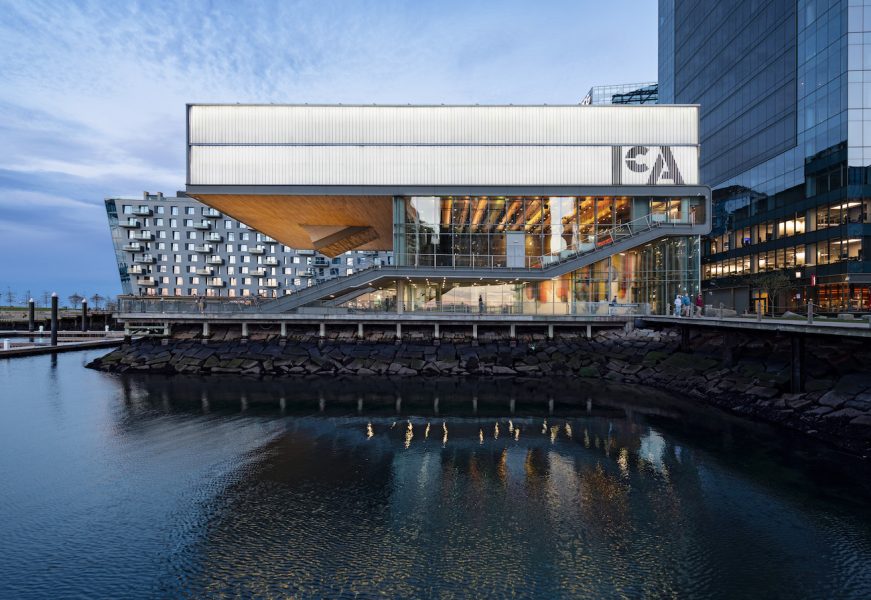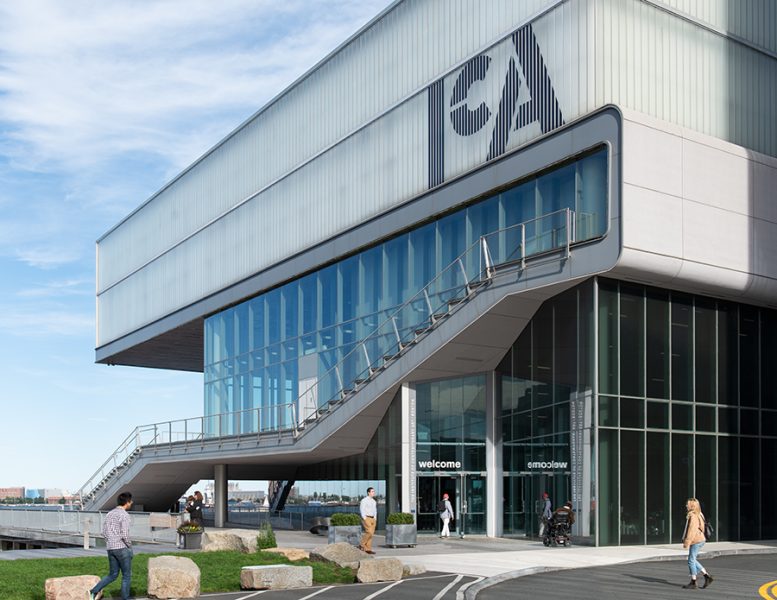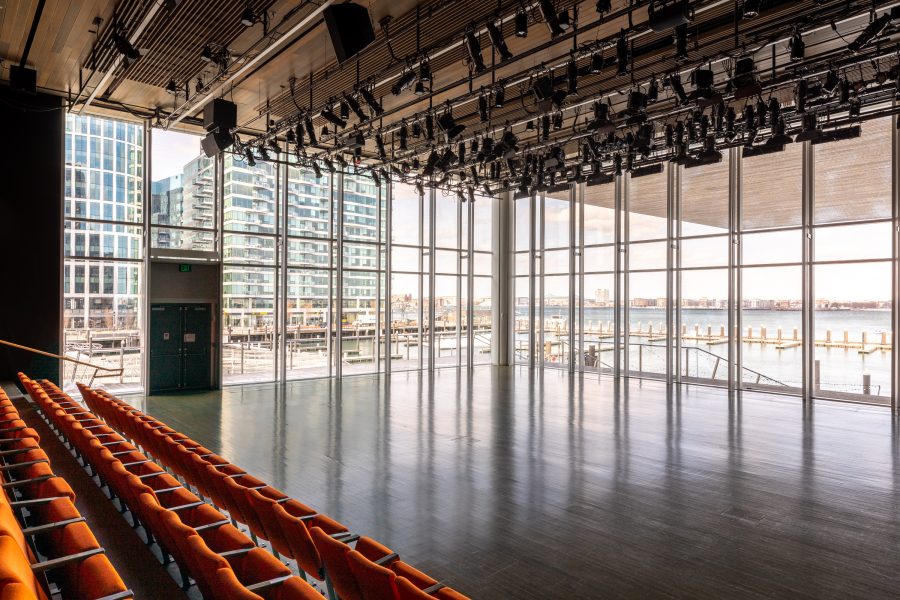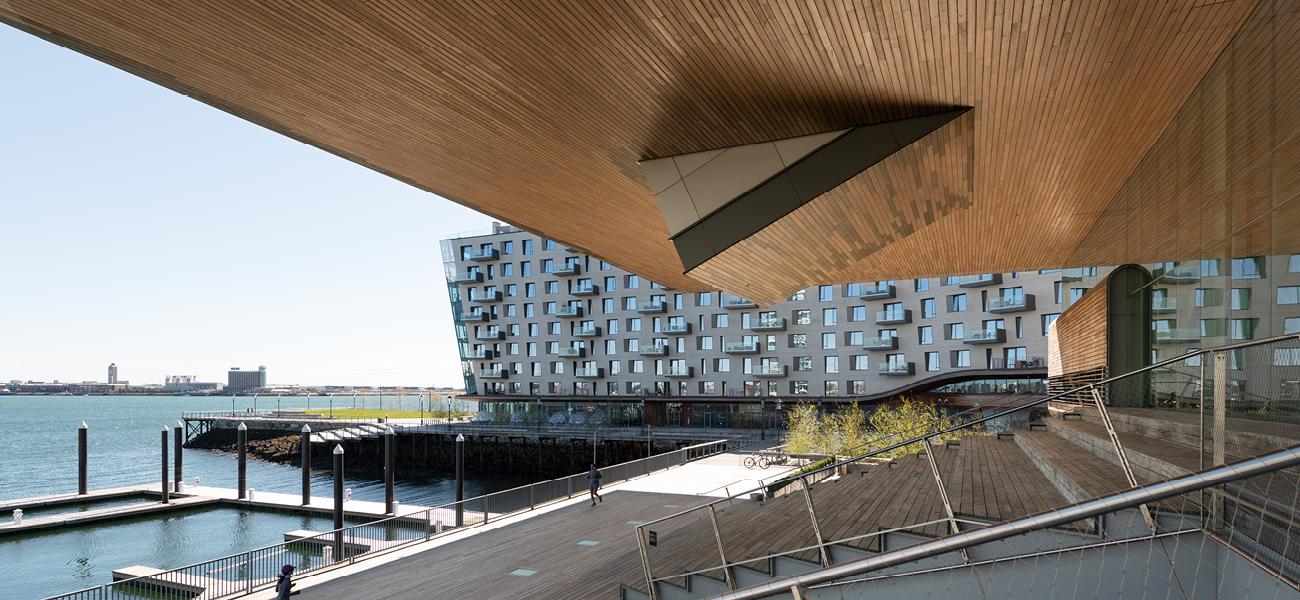The ICA’s visionary building captures the stimulation of contemporary culture and the excitement of a revitalized Boston waterfront.
Award-winning architects Diller Scofidio + Renfro designed the ICA—their first building in the U.S.—conceiving the building both “from the sky down,” as a contemplative space for experiencing contemporary art, and “from the ground up,” providing dynamic areas for public enjoyment. The design weaves together interior and exterior space, producing shifting perspectives of the waterfront throughout the museum’s galleries and public spaces.
Design Highlights
Exterior
The 65,000-square-foot building features a dramatic folding ribbon form and a cantilever that extends to the water’s edge. The façade consists of identically sized vertical planks that alternate between transparent glass, translucent glass, and opaque metal. The system provides a taut, seamless skin that blurs the distinction between walls, windows, and doors while responding to the requirements of the interior program.
State Street Corporation Lobby
The distinct tapering of the lobby directs visitors toward the Holly McGrath Visitor Center, with the bookstore directly behind facing the water. Along the eastern interior wall of the lobby is the Sandra and Gerald Fineberg Art Wall, a space dedicated to original work commissioned from a new artist each year. A 140-square-foot elevator with glass walls on the long sides gives a view of the harbor on one side, and all the floors passing by on the other.
Galleries
The museum’s flexible column-free galleries feature moveable walls, 15 ½–foot ceilings, an expansive adjustable skylight system allowing natural light to be filtered evenly throughout, and polished concrete floors. A glass wall facing the harbor is a special feature of the John Hancock Founders Gallery, which spans the entire width of the north end of the exhibition space and connects east and west galleries. The cantilevered galleries are supported by four massive trusses, which are silhouetted behind the translucent exterior walls. The “gallery box” can be illuminated by night to create a radiant, welcoming waterfront presence.
Barbara Lee Family Foundation Theater
The floor and ceiling of the 325-seat theater on the second and third floors is created through the extension of the wooden HarborWalk material from the public Jill Medvedow Grandstand into the interior of the building. The remaining walls are glazed in clear glass allowing the harbor view to become the backdrop behind the 51-foot stage. The glass walls can be controlled to meet performance needs—from full transparency, to filtered light and no view, to total blackout. Learn more about the theater
Poss Family Mediatheque
This vertically stepped-out space suspended from the underside of the cantilever features rotating interactive installations with resources to connect more deeply with current exhibitions on view. The space provides a stunning perspective of the water, framed as though through a viewfinder, with neither sky nor horizon in sight.
Charles and Fran Rodgers Education Center
This multi-faceted education center includes the Bank of America Art Lab, a workshop and classroom space for the ICA’s programs for adults, families, and teens on the museum’s first floor; and the Paul and Phyllis Fireman Family Digital Studio, a classroom where young people can learn creative and transferable skills and software and create digital works of art, located, since 2021, at the ICA’s Seaport Studio).
The Common Room and Putnam Investments Plaza
The north wall of the Common Room features sliding glass doors that face the Harbor. These 6-foot x 12-foot panels extend from floor to ceiling and slide over and stack to open up this the public space. The Putnam Investments Plaza is a 3,500-square-foot area adjacent to the Common Room and the bold Jill Medvedow Grandstand of public seating. The wood of the plaza merges with Boston’s 47-mile Harborwalk, which then continues inside the building as the floor and ceiling material of the theater. This sheltered outdoor space at ground level is a public area where people can enjoy views of Boston Harbor.
Chapter 91 License and Management Plan
Outdoor Public Spaces Calendar and Reports
Project History
In 1999, the ICA was unanimously selected to be the cultural cornerstone of the Fan Pier waterfront development. The opportunity enabled the ICA to envision a new home with expanded exhibition space, new programming, and a permanent collection—all housed within a progressive architectural statement that mirrors the museum’s foresight and risk-taking as a leading contemporary art venue. Opened in 2006, the ICA is a building of international architectural status, a world-class contemporary art venue, and an icon for Boston in the new century.
Support for capital improvements to the ICA has been provided by the Massachusetts Cultural Facilities Fund, a program of the Commonwealth of Massachusetts, administered through a collaborative arrangement between MassDevelopment and the Mass Cultural Council.
Support for furniture in the John Hancock Founders Gallery provided by the Yawkey Foundation.




